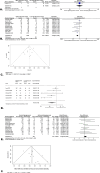Intrapartum maternal glycaemic control for the prevention of neonatal hypoglycaemia: a systematic review and meta-analysis
- PMID: 38872105
- PMCID: PMC11170869
- DOI: 10.1186/s12884-024-06615-8
Intrapartum maternal glycaemic control for the prevention of neonatal hypoglycaemia: a systematic review and meta-analysis
Abstract
Background: Neonatal hypoglycaemia is the most common metabolic disorder in infants, and may be influenced by maternal glycaemic control. This systematic review evaluated the effect of intrapartum maternal glycaemic control on neonatal hypoglycaemia.
Methods: We included randomised controlled trials (RCTs), quasi-RCTs, non-randomised studies of interventions, and cohort or case-control studies that examined interventions affecting intrapartum maternal glycaemic control compared to no or less stringent control. We searched four databases and three trial registries to November 2023. Quality assessments used Cochrane Risk of Bias 1 or the Effective Public Health Practice Project Quality Assessment Tool. Certainty of evidence was assessed using the Grading of Recommendations, Assessment, Development and Evaluation (GRADE). Meta-analysis was performed using random-effects models analysed separately for women with or without diabetes. The review was registered prospectively on PROSPERO (CRD42022364876).
Results: We included 46 studies of women with diabetes and five studies of women without diabetes: one RCT, 32 cohort and 18 case-control studies (11,273 participants). For women with diabetes, the RCT showed little to no difference in the incidence of neonatal hypoglycaemia between tight versus less tight intrapartum glycaemic control groups (76 infants, RR 1.00 (0.45, 2.24), p = 1.00, low certainty evidence). However, 11 cohort studies showed tight intrapartum glycaemic control may reduce neonatal hypoglycaemia (6,152 infants, OR 0.44 (0.31, 0.63), p < 0.00001, I2 = 58%, very low certainty evidence). For women without diabetes, there was insufficient evidence to determine the effect of tight intrapartum glycaemic control on neonatal hypoglycaemia.
Conclusions: Very uncertain evidence suggests that tight intrapartum glycaemic control may reduce neonatal hypoglycaemia in infants of women with diabetes. High-quality RCTs are required.
Keywords: Glycaemic control; Hypoglycaemia; Infant; Intrapartum; Labour; Neonatology; Newborn.
© 2024. The Author(s).
Conflict of interest statement
The authors declare no competing interests.
Figures




Similar articles
-
Severe neonatal hypoglycaemia and intrapartum glycaemic control in pregnancies complicated by type 1, type 2 and gestational diabetes.Diabet Med. 2020 Jan;37(1):138-146. doi: 10.1111/dme.14137. Epub 2019 Oct 11. Diabet Med. 2020. PMID: 31529717 Free PMC article.
-
Intrapartum glycaemic control and neonatal hypoglycaemia in pregnancies complicated by diabetes: a systematic review.Diabet Med. 2018 Feb;35(2):173-183. doi: 10.1111/dme.13546. Diabet Med. 2018. PMID: 29117445
-
Skin-to-skin contact for the prevention of neonatal hypoglycaemia: a systematic review and meta-analysis.BMC Pregnancy Childbirth. 2023 Oct 21;23(1):744. doi: 10.1186/s12884-023-06057-8. BMC Pregnancy Childbirth. 2023. PMID: 37865757 Free PMC article.
-
Early Feeding for the Prevention of Neonatal Hypoglycaemia: A Systematic Review and Meta-Analysis.Neonatology. 2024;121(2):141-156. doi: 10.1159/000535503. Epub 2024 Jan 9. Neonatology. 2024. PMID: 38194933 Free PMC article.
-
Intravenous Dextrose for the Treatment of Neonatal Hypoglycaemia: A Systematic Review.Neonatology. 2025;122(2):232-243. doi: 10.1159/000541471. Epub 2024 Nov 13. Neonatology. 2025. PMID: 39536722 Free PMC article.
Cited by
-
Recurrence of hypoglycaemia and associated factors among neonates admitted with perinatal asphyxia in Northwest Ethiopia: multicentre, retrospective follow-up study with negative binomial regression.BMJ Open. 2025 Apr 5;15(4):e096158. doi: 10.1136/bmjopen-2024-096158. BMJ Open. 2025. PMID: 40187778 Free PMC article.
-
Diabetes Mellitus in Pregnancy: Implications for Obstetric Anesthesia.Anesthesiology. 2025 Aug 1;143(2):424-443. doi: 10.1097/ALN.0000000000005534. Epub 2025 Jul 8. Anesthesiology. 2025. PMID: 40626748 Free PMC article. Review.
References
-
- Cornblath M, Hawdon JM, Williams AF, Aynsley-Green A, Ward-Platt MP, Schwartz R, et al. Controversies regarding definition of neonatal hypoglycemia: suggested operational thresholds. Pediatrics. 2000;105(5):1141–5. - PubMed
-
- Abramowski A, Ward R, Hamdan AH. Neonatal hypoglycemia. 2021 [cited July 3, 2023]. In: StatPearls [Internet]. Florida, FL: StatPearls Publishing, [cited July 3, 2023]. https://www.ncbi.nlm.nih.gov/books/NBK537105/.
-
- Harris DL, Weston PJ, Harding JE. Incidence of neonatal hypoglycemia in babies identified as at risk. J Pediatr. 2012;161(5):787–91. - PubMed
Publication types
MeSH terms
Substances
Grants and funding
LinkOut - more resources
Full Text Sources
Medical

